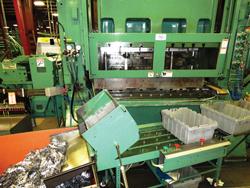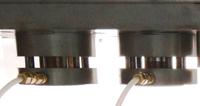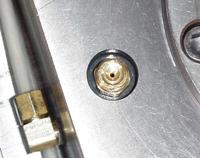Contributing Writer
- FMA
- The Fabricator
- FABTECH
- Canadian Metalworking
Categories
- Additive Manufacturing
- Aluminum Welding
- Arc Welding
- Assembly and Joining
- Automation and Robotics
- Bending and Forming
- Consumables
- Cutting and Weld Prep
- Electric Vehicles
- En Español
- Finishing
- Hydroforming
- Laser Cutting
- Laser Welding
- Machining
- Manufacturing Software
- Materials Handling
- Metals/Materials
- Oxyfuel Cutting
- Plasma Cutting
- Power Tools
- Punching and Other Holemaking
- Roll Forming
- Safety
- Sawing
- Shearing
- Shop Management
- Testing and Measuring
- Tube and Pipe Fabrication
- Tube and Pipe Production
- Waterjet Cutting
Industry Directory
Webcasts
Podcasts
FAB 40
Advertise
Subscribe
Account Login
Search
Stamping lubrication: Collect, recycle, reap the benefits
Recycling stamping lubricant may yield significant savings for the right application
- By Pat Ontrop
- November 7, 2011
- Article
- Bending and Forming

Figure 1: In some operations, a large quantity of lubricant is required to dissipate heat, which maximizes production speeds and tool life. Press doors contain the lubricant in the die area and direct it into the press trough for collection. Lubricant remaining on the parts is being reclaimed with an auxiliary bin system. After being filled with small parts, these bins are tipped at an angle to allow the lubricant to drain off of the parts and be collected. After this, parts are dumped into the larger bin.
While die lubricant can be costly to purchase, messy to apply, laborious to clean up, and expensive to dispose of, it also can help maximize production speed, tool life, and part quality. By choosing the right lubrication technique with various methods of containing, collecting, and recycling, a stamping operation can maximize production while minimizing the amount of lubricant used, along with the mess that typically comes with it.
A recycling strategy shouldn’t be implemented in isolation but instead be part of a broader lubrication strategy. Shop managers should first determine what lubricant their stamped parts require; how and where this lubricant needs to be applied; and how part geometry affects lubricant usage and reclamation practices (see Figure 1).
Application Methods
The application method can affect how much lubricant is used and how much can be recycled. For instance, some sprayers use a process called air atomization in which fluid is mixed with air. The emerging spray can cover a big area, but because air molecules mix with the fluid, the spray can hang in the work area like a mist. Airless spray applicators do not mix air with the fluid, which helps concentrate the lubricant application where it’s needed. This targeted application may also enable a greater percentage of the lubricant to be collected and recycled.
In-die application techniques can provide an optimal amount of lubricant just where it’s needed, effectively maximizing performance while minimizing lubricant usage. Methods of integrating lubrication into the die vary depending on the type of die, the part, and when the integration is done. If in-die lubrication is considered as part of the initial die design, it may be possible to plumb lubricant directly to critical punches (see Figure 2) or to bury spray nozzles within the die shoe (see Figure 3).
If this type of integration is not practical for a specific or existing die, a stamper can spray lubricant into the die where and when required. The most popular method is to attach magnetic-based spray assemblies to either the bolster or the slide and then aim these assemblies into the tooling at the desired location. While this method can be very effective, it is not always consistent, because each operator tends to set up and aim the spray assemblies differently.
A more precise and consistent alternative is to install bracket-mounted spray assemblies directly to the die shoes. These brackets are bolted to the die, and the nozzles are aimed as required to ensure the lubricant sprays exactly where desired. Then the nozzle and bracket are tightened into place. These nozzles typically are installed by toolroom personnel; when the die is later put into the press, the operator simply connects the spray line to the assemblies (see Figure 4).
Collection Methods
If only a small amount of lubricant flows out of the die shoe, it may be possible to collect it by simply milling a groove around the die shoe’s perimeter, and then draining the captured lubricant into a collection area. A more common method, though, is to allow lubricant to run across the bolster and be captured by the oil trough on the press bed. Once the lubricant is captured in the press trough, it then drains to either the press pit or another common collection point.
If lubricant must be sprayed on before entering the die, spray cabinets can help (see Figure 5). Within these enclosures are spray nozzles that coat the top and bottom of the material as it exits the feeder. In this noncontact application method, the cabinet contains and collects lubricant that drips off the stock, and then drains this lubricant back into the system, where it can be filtered and reused.
If lubricant is splashed out of the die area, a splash guard, press door, or similar structure can be used to contain it. Some press doors also are designed to collect this lubricant and drain it to a common collection point, which may be the press oil trough (see Figure 6). In these setups, the bottom of the press door is flush with the press bolster, and a collection trough is built into the bottom of the door.
If lubricant splashes out of the tooling, it contacts the door and flows down into the door’s trough. This fluid is then drained into the press trough. If a press does not have a built-in trough, one can be retrofitted onto the press, or the captured lubricant can be directed to an alternative collection point.

Figure 2: Proper punch lubrication may require introducing the lubricant directly into the punch, as opposed to spraying it.
Certain applications, including ones involving flood lubrication, call for splash guards either in place of or in addition to press doors. These guards, which come in many forms, can be permanently installed as part of the die. Alternatively, removable magnetic guards can be used (see Figure 7). In these setups, splashed lubricant hits the guard and drips onto the bolster, where it collects with other lubricant flowing from the die.
In many applications, keeping the tooling cool can be a critical factor for increasing tool life. Water-soluble lubricant is often used to achieve this cooling. When this lubricant is sprayed onto the hot tooling, steam is created, which can float out into the shop, making for an unpleasant and potentially unsafe work environment. To contain this steam and the lubricant within it, many companies install press doors on the front and back of the press, and also cover the upright openings. To collect the contained steam, exhaust/filtration systems are mounted on the outside of each upright. These systems pull the steam out of the die area, collect the lubricant from the steam, and release the clean air into the pressroom (Figure 8).
Often stamped parts and scrap actually carry a significant amount of lubricant out of the press. To reclaim a portion of this lubricant, some stampers install an oil collection device at the end of the conveyor or chute where the parts or scrap exit the press. The exit chute shown in Figure 9, for instance, captures the lubricant dripping off the parts as well as the conveyor. The captured lubricant then is drained into the press trough.
If the parts and scrap are gathered in a bin, the bin itself can help collect additional lubricant. Letting a bin sit for a period of time allows for some lubricant from the parts to drain to the bottom for collection. Later the bin can be tilted to allow even more fluid to drain (Figure 10). How effective this collection method is depends on the part geometry.
Recycling Strategy
Whether or not the collected lubricant can be reused depends on the part requirements and the contamination level of the collected lubricant. Some critical applications may specify highly polished, cosmetically important surfaces, which would require the use of virgin lubricant.
In some applications, the amount of contamination in the lubricant varies. In these cases, it may be possible to collect the more contaminated lubricant in one location, such as the press pit, and collect the less contaminated lubricant in a second location, such as a stainless steel reservoir. Stainless steel is recommended because it is typically easier to keep clean, which helps minimize bacteria growth—a common problem when recycling water-soluble lubricants.
If the captured lubricant is to be recycled, it must be appropriately filtered and periodically tested. The level and type of filtering required depends on the type of contamination that needs to be removed. In many cases, the lubrication system’s standard filter arrangement is sufficient, but supplemental filtering systems may be required if a particular type of contaminant needs to be removed. Magnetic systems can be used to remove steel fines from some used lubricant, and skimming systems can be used to remove certain unwanted oils, such as oils used to lubricate the coil.
Filtered lubricant must be tested periodically to ensure its concentration is correct, with the right levels of key properties. If an application uses water-soluble lubricant, more water may need to be added to the captured lubricant to replace water that was lost as steam during stamping. Water-soluble lubricants also may need additives to eliminate and prevent the forming of harmful bacteria. The lubricant supplier should be able to identify the steps to successfully recycle a specific type of lubricant.
Applying, Containing, Recycling
Applying the right amount of lubricant in the right areas may allow faster press speeds, longer die life, and more consistent part quality while minimizing the amount of lubricant consumed. Containing and collecting as much of the remaining lubricant as possible improves the work area’s overall cleanliness and safety and helps to protect the environment. Cleaning and recycling this lubricant, when possible, further reduces costs and environmental impact. Overall, successfully implementing a total system of applying, containing, and recycling lubricant can result in tremendous bottom-line benefits.
About the Author
subscribe now

The Fabricator is North America's leading magazine for the metal forming and fabricating industry. The magazine delivers the news, technical articles, and case histories that enable fabricators to do their jobs more efficiently. The Fabricator has served the industry since 1970.
start your free subscription- Stay connected from anywhere

Easily access valuable industry resources now with full access to the digital edition of The Fabricator.

Easily access valuable industry resources now with full access to the digital edition of The Welder.

Easily access valuable industry resources now with full access to the digital edition of The Tube and Pipe Journal.
- Podcasting
- Podcast:
- The Fabricator Podcast
- Published:
- 04/16/2024
- Running Time:
- 63:29
In this episode of The Fabricator Podcast, Caleb Chamberlain, co-founder and CEO of OSH Cut, discusses his company’s...
- Trending Articles
AI, machine learning, and the future of metal fabrication

Employee ownership: The best way to ensure engagement

Steel industry reacts to Nucor’s new weekly published HRC price

Dynamic Metal blossoms with each passing year

Metal fabrication management: A guide for new supervisors

- Industry Events
16th Annual Safety Conference
- April 30 - May 1, 2024
- Elgin,
Pipe and Tube Conference
- May 21 - 22, 2024
- Omaha, NE
World-Class Roll Forming Workshop
- June 5 - 6, 2024
- Louisville, KY
Advanced Laser Application Workshop
- June 25 - 27, 2024
- Novi, MI



























